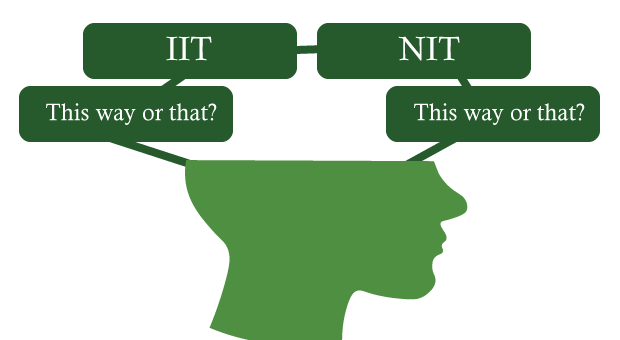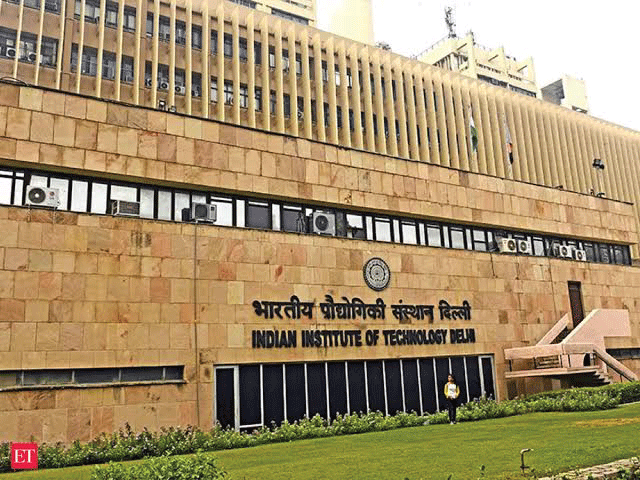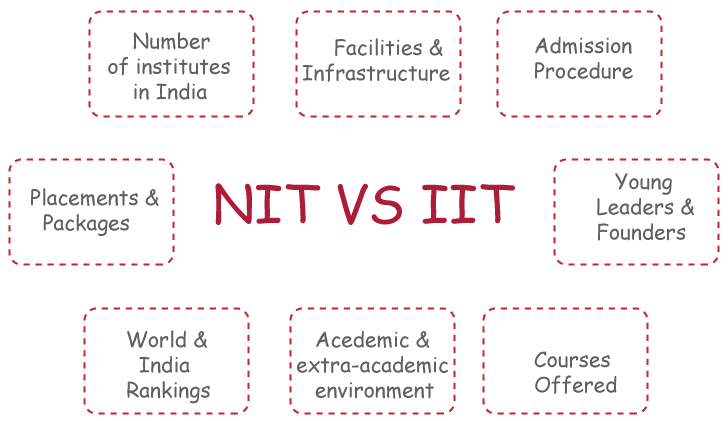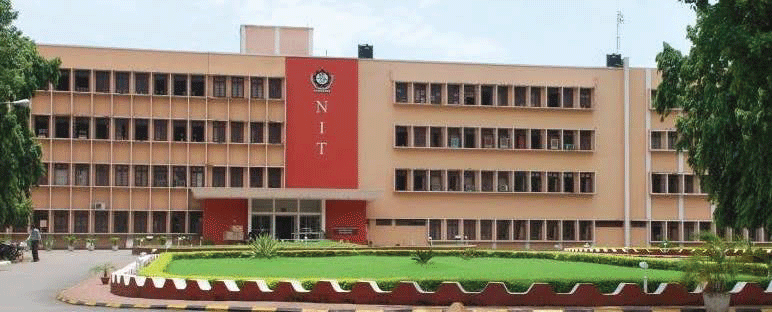Difference Between IIT and NITTwo of India's most prominent engineering institutions are the Indian Institutes of Technology (IITs) and the National Institutes of Technology (NITs). Both are government-funded universities that offer undergraduate and postgraduate engineering and technology programs. 
IIT and NITs have a rich academic structure and have produced notable alums who have contributed significantly to various fields. Personal choice, educational background, and career ambitions all play a factor in determining which of the two institutions to study. Indian Institutes of Technology (IIT)The Indian Institutes of Technology (IITs) are well-known public technical institutes owned by the central government and located all over India. They are known for their educational quality and are owned by the Government of India's Ministry of Education. The Institutes of Technology Act of 1961 assigned them as Institutes of National Importance established their powers, responsibilities, and governance structure as the country's leading technology institutions. There are currently twenty-three IITs listed under the act. Each IIT is autonomous and is linked to others through the IIT Council which is a common council that governs its administration. History of IITSir Jogendra Singh of the Viceroy's Executive Council set up a committee in 1946 to examine the establishment of Higher Technical Academic Institutions in India to post-war industrial development. The 22-member council, led by Nalini Ranjan Sarkar, advised that these institutes, similar to the Massachusetts Institute of Technology (MIT), be established in various sites around India, with connected secondary colleges. In May 1950, the first Indian Institute of Technology was established on the site of Hijli Detention Camp in Kharagpur, West Bengal. The term "Indian Institute of Technology" was chosen by Maulana Abul Kalam Azad before the institute's formal inauguration on August 18, 1951.On September 15, 1956, the Indian Parliament passed the Indian Institute of Technology (Kharagpur) Act, certifying it as an Institution of National Importance. According to the Sarkar Committee's recommendations, four campuses were established in Bombay (1958), Madras (1959), Kanpur (1959), and Delhi (1959). (1961). To avoid regional imbalance these institutions were strategically placed throughout India. 
The Indian Institutes of Technology Act was amended to approve the addition of more IITs. As a result of student protests in Assam, Prime Minister Rajiv Gandhi promised the establishment of a new IIT in the state. As a result of the Assam. According 1994, a sixth institution was established in Guwahati. In 2001, the University of Roorkee was converted into IIT Roorkee. Many advances have occurred in recent years toward the establishment of new IITs. On October 1, 2003, Prime Minister Atal Bihari Vajpayee announced plans to create new IITs "by improving existing academic institutions that have the necessary promise and potential". Following this, in November 2003, the S K Joshi Committee was formed to advise selecting the five colleges that would be turned into IITs. It was planned to create new IITs from across country based on the initial ideas of the Sarkar Committee. 16 states wanted IITs after the government announced its willingness to redress this regional imbalance. Because the S K Joshi Committee imposed stringent standards for institutions aspiring to be IITs, only seven colleges were selected for final consideration. There are also plans to open IITs outside of India, albeit more progress has yet to be made. Finally, eight states were designated in the 11th Five-Year Plan for developing new IITs.Eight new IITs were established between 2008 and 2009 at Gandhinagar, Jodhpur, Hyderabad, Bhubaneswar, Indore, Patna, Ropar, and Mandi. Following a similar selection procedure in 1972, Banaras Hindu University's Institute of Technology was made the IITs in 2012 and re-named IIT (BHU) Varanasi. From 2015 to 2016, six new IITs were established in Tirupati, Palakkad, Dharwad, Bhilai, Goa, and Jammu, because of a 2016 bill amendment, as well as the conversion of Indian School of Mines Dhanbad in to the IIT (Indian School of Mines), Dhanbad. The central government allocated slightly more than 70 billion rupees for all Indian Institutes of Technology (IITs) in 2017-18 budget. Yet, the total amount spent by Indian students on tertiary education in the United States was almost six times greater than the total amount paid by the central government on all IITs. Academics of IITThe IITs receive far more funding than other engineering institutes in India. While most other engineering colleges receive approximately 100-200 million ($2-4 million) per year from the government, each IIT gets between 900-1300 million ($19-27 million) every year. Additional financing sources include student fees, industry research grants, and alums contributions. In the IITs, the faculty-to-student ratio ranges between 1:6 and 1:8. When applied departmentally, the Standing Committee of the IIT Council (SCIC) prescribes a faculty-to-student ratio of 1:9. 
According to the Thacker Committee's recommendations, the IITs Subsidize around 80% of undergraduate student expenditures and grant scholarships to all Master of Technology students along with Research Scholars (Ph.D.) to encourage students to seek higher study. Undergraduate students pay approximately $180,000 each year. students from the OBC, ST, SC, female, and physically challenged groups are also eligible for scholarships. Admission to IITStudents must pass the JEE Main and JEE Advanced exams to gain access to IITs. They must have at least 70 to 75% on their board test or be in the top 20% of their board. The top 2.5 lakh JEE Main scorers are eligible for JEE Advanced. Students must also pass the JEE Advanced Cut-Off. This also relates to admissions to bachelor's degree programs in architecture. The IITs have approximately 11,000 seats available for B.Tech specialties. When it comes to the level of study, IITs and NITs are different. Compared to NITs, IITs have a higher-quality infrastructure of courses, breadth, faculties, and top-scoring students. On the other hand, compared to best private colleges NITs have batches of hardworking and intelligent students. Nonetheless, NITs are always a student's second option. IITs provide diverse courses taught by highly trained professors who prefer creative teaching strategies. The specific curriculum can be found by visiting either college's official website and searching for 'Undergraduate Courses' offered by that college. Students must clear the required cut-off for that specific course to get the finest techniques. You need to score above 250 in JEE Main to get into IIT. Both IITs and NITs give several studies in the technological field. Also, the most crucial aspect is the variety of specializations available at both campuses, with enough support from the professors. National Institutes of Technology (NIT)The National Institutes of Technology (NITs) are public technical institutes owned by the central government and managed by the Government of India's Ministry of Education. The National Institutes of Technology, Science Education and Research Act of 2007 established them as institutions of national importance and established their powers, tasks, and governance framework. The act specifies 31 NITs. Each NIT is autonomous, although they are linked to one Another is monitored by a common group is known as the Council of NITSER, and the Government of India supports all NITs. In engineering, twenty-four NITs were ranked in the top 200 by the National Institutional Ranking Framework in 2020. English is the language of instruction at all of these institutes. As of 2022, the overall number of undergraduate seats is 23,997, while the total number of postgraduate seats is 13,664 throughout all 31 NITs. History of NITDuring the second five-year Plan, several industrial projects in India were proposed (1956-60). The national government established Regional Engineering Colleges (RECs) to act as regional replicas of IITs and as models for all other colleges in that state. Admission used to be highly competitive. Students who pass their respective state's 12th board test may be admitted to their state's REC. As a result, 17 RECs were formed in each significant state beginning in 1959. Each college was a collaborative and cooperative initiative of the central government and the relevant state government. In 1960, the government established 9 RECs, two in each region on average. These were large-scale institutions measured by the country's standards at the time. Bigger institutions would be more efficient than smaller colleges; nevertheless, the proposed institutions must meet the additional demands of the country overall and function on an all-India basis. As a result, the fewer they are and the larger their size, the better, and their location is crucial from an all-India perspective. The central government and the related state government worked together to run the RECs. Throughout the REC period, the central government paid non-recurring expenses and postgraduate course fees. In contrast, the central and state governments divided recurrent expenditure into undergraduate courses equally. Even before their designation as National Institutes of Technology, they were regarded as India's best government engineering institutes after the IITs. 
Because of the growth of the technology-based industry, technical and scientific education is in high demand. Because of the enormous costs and infrastructure required to establish globally renowned Indian Institutes of Technology (IITs), Minister Murli Manohar Joshi of the Ministry of Human Resources Development (MHRD) made the decision in 2002 to upgrade RECs to "National Institutes of Technology" (NITs) rather than create IITs. The central government supervises and funds NITs. All RECs were converted to NITs in 2002.As it was determined that RECs had potential, as seen by their graduates' performance and contributions to technical education, they collaborated with the IITs, and the upgrading was structured after the Indian Institutes of Technology (IITs). As a result, NIT funding and autonomy have expanded, and now they offer degrees that have enhanced the perceived value of its graduates. These modifications carried out the suggestions of the "High Powered Review Committee" (HPRC). In 1998, the HPRC released its report, "Strategic Road Map for Academic of Excellence of Future RECs," chaired by R. A. Mashelkar. Future NITs are either transformed from existing institutes or developed from scratch based on state government requests and feasibility. The government officially confirmed the establishment of 10 additional new NITs in the remaining states/territories in 2010, bringing the total number of NITs to 30. As a result, every state in India would have its own NIT. The NITs and IITs receive significantly higher grants than other engineering institutes in India. By 2011, the average NIT funding had risen to One hundred crores ($15.4 million). Other financing sources include student fees, industry research grants, and alums contributions. Undergraduate students pay approximately $250,000 ($3600) per year. After students from the SC and ST categories, physically challenged students will be eligible for fee agreements at the Indian NITs. Academics in NITThe numerous NITs operate autonomously, and their unique status as Institutes of National Significance aid the smooth running of NITs, which are mainly free of regional and student politics. Because of this autonomy, NITs can develop their curricula and respond quickly to changes in educational requirements. Classes are typically offered between 8:30 a.m. and 5:30 p.m., though this varies by Subject. All NITs have public libraries for their students' use. The libraries have fiction and many other literary genre sections and a required book collection. With the AICTE-INDEST partnership, a Ministry of Human Resource Development curriculum, electronic libraries provide students with access to online journals and other publications. IEEE materials and magazines are also available to students. 
The Senate of each NIT determines its academic policies. This group includes all NIT professors as well as student representatives. The NITs, unlike many Western universities, have an academic senate rather than an elected senate. It oversees and approves the curriculum, courses, exams, and outcomes and creates committees to investigate specific theoretical issues. The Senate regularly reviews the institute's teaching, training, and research activities to maintain educational standards. The Director of NIT serves as the Senate's ex-officio Chairman. Admission to NITAdmission to National Institutes of Technology (NITs) normally consists of many processes. Candidates must first take a national-level admission exam, such as JEE Main or JEE Advanced. They will be shortlisted for additional rounds, which may involve counselling and seat allocation, based on their exam performance They must, however, pass the NIT cut-off, NTA administers JEE Main. Earlier, CBSE issued this test. However, the MHRD chose to delegate responsibility for JEE Main to NTA. Around 20,000 seats in various B. Tech programs are available at NITs. Candidates are given the opportunity to select their desired NIT and course during counselling. Once the seats have been assigned, candidates must confirm their acceptance by paying the applicable fees and completing the relevant paperwork. Overall, NIT admissions are highly competitive and demanding, with a significant emphasis on academic quality and performance. Similarities Between IITs and NITs
IITs and NITs admit students through the Joint Entrance Examination, a highly competitive national-level entrance exam (JEE). The JEE is divided into two stages, JEE Main and JEE Advanced, and is regarded as one of the most difficult entrance exams in the world.
IITs and NITs are primarily concerned with providing education in engineering and technology. They provide undergraduate, postgraduate, and doctoral programs in various disciplines, such as mechanical, electrical, computer science, civil, and chemical engineering.
IITs and NITs provide a comprehensive curriculum with a strong emphasis on technical education and research. The courses give students a solid foundation in their chosen field and a broader understanding of engineering principles and applications.
Both IITs and NITs are government-funded public institutions. This means that, compared to private institutions, the fees for both institutions are relatively low, making them accessible to students from a wide range of socioeconomic backgrounds.
Both IITs and NITs have an extensive and influential alum network with prominent positions in various fields all over the world. These alums have significantly contributed to academia, research, and industry.
IITs and NITs have a vibrant campus life with various cultural, sports, and extracurricular activities that provide students with holistic development. Both institutions' campuses are well-equipped with cutting-edge infrastructure, such as libraries, laboratories, sports facilities, and other amenities. Difference Between IIT and NIT
ConclusionIITs and NITs are both highly regarded public institutions in India that provide undergraduate, postgraduate, and doctoral programs in engineering and sciences. However, there are some significant differences between the two, including funding, ranking, curriculum, and student quality. IITs typically offer a more theoretical and research-oriented curriculum, as well as a more competitive admissions process and better-funded infrastructure. NITs, on the other hand, focus more on practical and application-based education and may admit a broader range of students based on quotas. Finally, the decision between an IIT and an NIT is determined by the individual's specific needs and goals.
Next TopicDifference Between
|
 For Videos Join Our Youtube Channel: Join Now
For Videos Join Our Youtube Channel: Join Now
Feedback
- Send your Feedback to [email protected]
Help Others, Please Share










